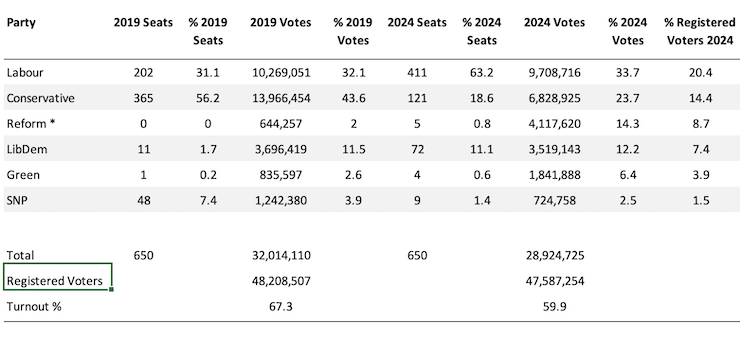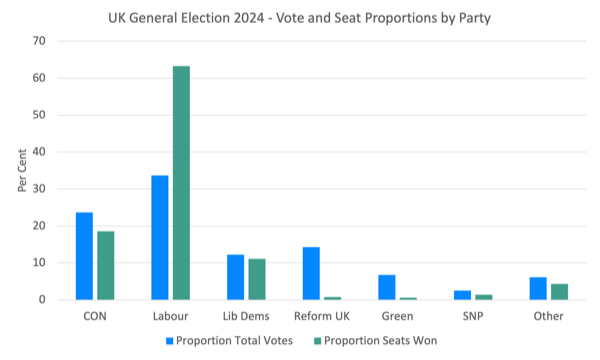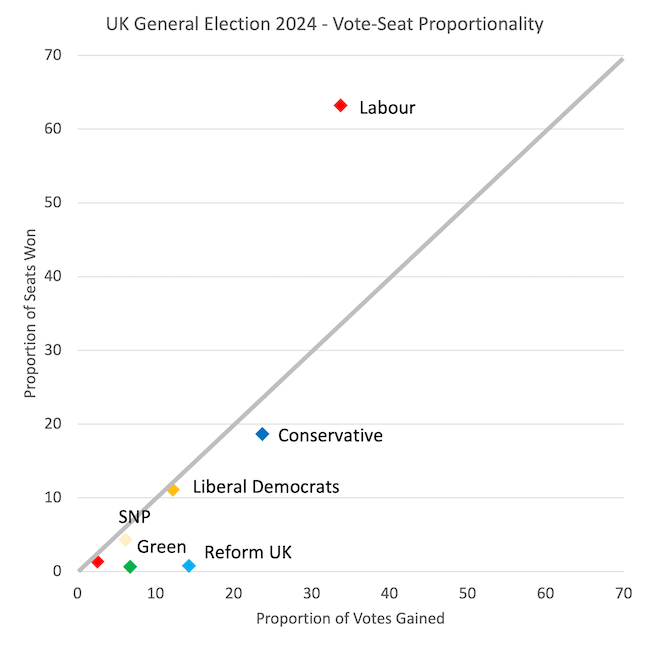My blog is on holiday until Tuesday, January 6, 2026. We are planning to finish…
British Labour’s election victory looks very unconvincing when we dig into the data
The UK General Election was held on Thursday, July 4, 2024 and the British Labour Party stormed home winning 411 of the 650 seats in the House of Commons to take a huge simple majority of 174 seats. The awful Tories were cleaned out well and truly and only managed 121 seats a loss overall of 251 seats. The Liberal Democrats improved their seat holding by 64 to end up with 72 (a rather dramatic reversal after they were shunned for siding with the Tories in past Parliaments). So for those who hate the Conservatives this was, on the face of it a huge win, surely. Not quite. In fact, despite the simple statistics above, Labour only gained a 1.7 per cent swing despite 14 years of shocking Tory rule, while the Tories endured a swing of 19.9 percentage points. In fact, the result highlighted the failed electoral system used in Britain – first past the post – when there are more than 2 parties involved, not to mention the demonstration of national apathy as captured by the 59.9 per cent turnout in the voluntary system, which was down by 7.4 percentage points on the last election. In other words, British Labour, despite all the hubris from the leadership actually performed pretty badly gaining 33.7 per cent of the 59.9 per cent who bothered to vote. And, into the bargain, their total vote dropped from 10,269,051 to 9,708,716. When considered in terms of the total registered voters then Labour was preferred by only 20.4 per cent. From the perspective of an outsider, these numbers are simply stunning and do not resonate with any reasonable concepts of representative government. The joker in the pack was, of course, the entry into the election of Reform UK, which effectively split the conservative vote and in this sort of electoral system grossly distorts the overall outcome. I conclude that British Labour can hardly claim to be in a safe position and less people wanted them to govern than when Jeremy Corbyn was leader.
Extensive data is available from the British House of Commons Library and they have now updated the full – General election 2024 results (as of July 23, 2024) – which gives number crunchers like me the chance to explore the results below the superficial level.
I was interested in a number of conjectures which I will be examining in more detail using econometric analysis (to test behavioural hypotheses) in the coming weeks.
But for now, given I only have had the data for a day or so, I wondered what would have happened if the Tory vote hadn’t split.
In the 2019 general election, there was a Farage-element in the form of the Brexit Party which gained no seats but attracted 2 per cent of the total vote (644,257 votes).
That was in a much larger total vote pool (given the turnout was much higher in 2019).
The following table provides a comparison of the seats and votes in the 2019 and 2024 General election and demonstrates the ridiculous outcomes that the first past the post system generates when there are more than 2 parties garnering significant vote numbers.
Labour gained 411 seats in 2024 relative to 202 in 2019, even though their vote went down.
Reform UK gained on 5 seats in 2024 with 14.3 per cent of the vote, while the Liberal Democrats gained 72 seats with less overall votes (12.2 per cent of total).
The sum of the Conservative and Reform UK votes delivered 126 seats (compared to Labour’s 411) even though these two parties gained 38 per cent of the total vote compared to Labour’s 33.7 per cent.
And when you think in terms of the total registered voters, the Labour government is in a dominant legislative position despite only gaining 20.4 per cent of the total eligible votes.
All pretty amazing really.
The next graph shows this data in a different way, comparing the proportion of total votes gained against the proportion of total seats won.
The Labour result is clearly an outlier which has been created by two conservative-type parties eating each other up.
Note: I also think the Labour party is, effectively, a conservative (right-centre) party but it is slightly different in ideology to the Tories and Reform UK.
The next graph demonstrates how disproportionate the Labour victory is in relation to one-person-one vote type thinking.
The 45-degree line marks strict proportionality.
The next question I was interested in, which is easily answered without sophisticated statistical tools (so I had enough time today to do it) was what would have been the outcome if the conservative vote hadn’t splintered so badly.
It is clear that the dynamic of the election was to get rid of the Tories, who had delivered such poor government over the last 14 years.
That was, in my view, the only unambiguous message of the election.
However, the voters also were not attracted to the message that the Labour Party was pumping out and many on the Left probably were among those who didn’t bother to turnout to vote, given the behaviour of the Starmer-Rayner-Reeves troika, who systematically purged the progressive elements in the Party using the disgusting ruse of anti-semitism.
That was, in my view, the other relatively clear message of the election.
So the disenchanted Tory voters went for the closest thing – Nigel Farage and his gang of racist and xenophobes.
I suspect that when the dust settles and if the Tories keep the likes of Rees Mogg and Liz Truss out of the political process, a lot of the UK Reform vote will leak back to the Tories in 5 years time.
It may not but I don’t think it will leak to Labour, which is the point.
So what would have been the outcome if the Reform UK had not contested the election and the votes were considered ‘conservative’?
I went through each of the 650 constituencies and allocated the Reform UK vote to the Conservative vote and recalculated the first part the post outcome in each seat.
The results are as follows.
1. The official results gave the Labour Party 411 seats (64.9 per cent of the total 650 seats).
2. If we added the Conservative and Reform UK vote together and then recalculated the first past the post outcome for each constituency, then Labour would have won just 267 seats.
3. The Conservative and Reform UK coalition would have won 303 seats (up from the 121 seats the Conservatives won and the 5 seats Reform UK won).
4. If we assume that the the ‘pure’ Reform UK votes were reflected in the Brexit Party proportions in 2019 (a big assumption I know) and we net that proportion out of the Reform UK vote in 2024 and then add the Conservative and Reform UK vote and repeat the constituency-by-constituency outcome we get:
Labour: 316 seats
Conservative-Net Reform UK: 274 seats.
I will be able to dig deeper into the results when I get more time.
But, whichever way one looks at it, the Labour result is unconvincing.
They better do something significant to improve the situation in Britain or else they won’t last that long.
Book Event – Melbourne, September 12, 2024
Readings Bookshop has now updated the site for our event – Bill Mitchell with Alan Kohler – which will be held at the Hawthorn Shop (687 Glenferrie Rd, Hawthorn, Victoria, 3122) on Thursday, September 12, starting at 18:30.
I will be there with ABC Finance personality Alan Kohler to discuss my new book (co-authored by Warren Mosler) – Modern Monetary Theory: Bill and Warren’s Excellent Adventure.
Copies of the book will be available at discount prices and my pen might come out if you want it signed.
You need to book for the event (about 50 tickets are available) which is free but limited.
You can book – HERE.
I hope to see all the MMT Melbourne crew there (well at least 50 of you).
That is enough for today!
(c) Copyright 2024 William Mitchell. All Rights Reserved.



Having won in 2024, Starmer’s new objective will be to win a second term in 2029. To achieve this objective he will have to hit the various targets he has set for his government: to reduce waiting lists in the NHS, to build 1.5 million dwellings over the next 5 years, to rebuild national infrastructure and, more generally, to increase the economic growth rate.
Yet, the fiscal rules that he adopted to win the general election have robbed him of the very spend and tax rules that are required to deliver this ‘change’. The interesting political question is how will Starmer deal with this problem that he has given himself. On past performance, there are good reasons to believe that Starmer will not allow earlier commitments to restrict his freedom of action as Prime Minister.
I expect the fiscal credibility rules will be ditched or revised once Starmer sees them as a hindrance to achieving the changes that will be essential for him to win a second term in 2029.
I follow points 1 to 3 but then get lost with point 4. Does anyone have a fuller explanation please?
Dave – I think what he’s saying is that in point 3 the numbers he gives come from combining the Reform vote with the Conservative vote, but in point 4 he is recognising that there is a proportion of the Reform vote that would not switch back to Conservative (those that voted Brexit Party in 2019) and so the figures in point 4 take account of the fact that it is not likely that the entire Reform vote can be realistically combined with the Conservative vote. Hence the effect is that fewer seats are won by the combined Reform-Conservative vote (274 rather than 303) because the ‘pure’ Reform voters would continue to split the right wing vote.